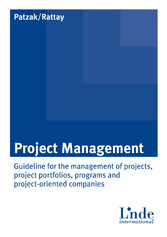Suchen und Finden
Service
Mehr zum Inhalt

Project Management - Guideline for the management of projects, project portfolios, programs and project-oriented companies
Titelei
4
Introduction
6
Content
10
Part I: Basics
14
1 Basics
16
1.1 Project and Project Management Basics
16
1.1.1 Perception of Projects
16
1.1.2 Types of Projects
17
1.1.3 Project Management Tasks
20
1.1.4 Systems Approach to Project Management - The Big Picture
22
1.1.5 Benefits of Project Management
27
1.1.6 Project Management Success
28
Part II: Project
30
2 Project Management in the Project Start-Up Phase
32
2.1 Project Initiation and Project Environment (Project Preparation)
32
2.1.1 Initial Project Scenarios
32
2.1.2 Project Development Process
36
2.1.3 Project Worthiness
38
2.1.4 Project Preparation
39
2.1.5 Project Environment and Stakeholder Analysis
40
2.1.6 Strategic Preparation of Change and Claim Management
51
2.2 Project Assignment and Project Start-Up Process
60
2.2.1 Project Definition (Project Charter, Project Description, Project Statement)
60
2.2.2 Opportunity and Risk Management at Project Start-Up
74
2.2.3 The Project Start-Up Process
76
2.2.4 Typical Forms of Communication in the Start-Up Process
80
2.3 Establishing Project Organization
83
2.3.1 Role Concept
84
2.3.2 Role Conflicts
85
2.3.3 Project-Related Roles
86
2.4 Forming of Project Teams
111
2.4.1 Selection of the Project Manager
111
2.4.2 Selecting Project Team Members
114
2.4.3 Forms of Project Team Organization
116
2.4.4 Phases of Team Development
119
2.4.5 Formation of (Virtual) Distributed Teams
122
3 Project Planning and Execution Phase
134
3.1 Managing the Project Environment
134
3.1.1 Project Marketing
134
3.1.2 Procurement and Contracts with Suppliers
137
3.2 Project Planning
144
3.2.1 General Thoughts on Planning
144
3.2.2 Task Planning (Work Planning)
148
3.2.3 Quality Planning
162
3.2.4 Process Logic and Time Scheduling
172
3.2.5 Resource Planning
198
3.2.6 Cost Planning and Financial Planning
210
3.2.7 Integrated Optimization in Project Planning
226
3.2.8 Risk Planning
227
3.3 Managing Project Organization
243
3.3.1 Interface Planning
243
3.3.2 Task Allocation within the Project Team
245
3.3.3 Managing the Project Information System
250
3.4 Managing Project Teamwork
279
3.4.1 Project Team Culture
279
3.4.2 Leadership of Project Teams
280
3.4.3 Problem Solving and Evaluation Methods in Teams
289
3.4.4 Team Decision Processes
293
3.4.5 Virtual Team Work in the Planning and Execution Phase
296
4 Coordination and Change Phases in Projects
298
4.1 Environmental Changes around Projects
298
4.1.1 Change Management
298
4.1.2 Claim Identification and Claim Assertion
301
4.2 Project Control
306
4.2.1 Overview of Controlling Tasks
306
4.2.2 Project Controlling Procedure and Instruments
309
4.2.4 Crisis Management
334
4.3 Project Organization
339
4.3.1 Organizational Integration of Project Controlling
339
4.3.2 Changes in Project Organization (Project Team)
342
4.3.3 Meetings in Coordination Phases
343
4.4 Project Teamwork
344
4.4.1 Meeting Management
344
4.4.2 Teamworking Methods and Tools
355
4.4.3 Conflict Management
357
4.4.4 Virtual Teamwork in the Project Coordination Phases
370
5 Project Close-Down Phase
372
5.1 Closing Relations with Stakeholders
372
5.1.1 Characteristics of the Project Close-Down Phase
372
5.1.2 Defining an Appropriate End to the Project
372
5.1.3 Project Delivery Process
374
5.1.4 Dissolving Relevant Stakeholder Relations
375
5.1.5 Claim Management in the Project Close-Down Phase
379
5.2 Project Evaluation
379
5.2.1 Final Project Calculation
379
5.2.2 Project Close-Down Report
380
5.2.3 Open Issues
382
5.3 Dissolving the Project Organization
383
5.3.1 Project Close-Down Meeting
383
5.4 Dissolving the Project Team
385
5.4.1 Opportunities and Problems when Dissolving the Project Team
385
5.4.2 Utilizing Learning Opportunities
386
Part III: Project Portfolio / Project Program
388
6 Strategic Conception of Project Portfolios and Programs
390
6.1 Project Portfolio Definition
390
6.2 Program Definition
391
6.3 The Importance of Project Portfolios in Modern Organizations
392
6.4 Goals and Benefits of Project Portfolio Management
392
6.5 Goals and Benefits of Program Management
393
7 Organizational Structures of Project Portfolios and Programs
396
7.1 Roles in Project Portfolios and Programs
396
7.1.1 Project Portfolio Steering Committee, Project Portfolio Coordinator
397
7.1.2 Project Portfolio Controller
400
7.1.3 Program Manager
400
7.1.4 Program Steering Committee
402
7.1.5 The Role of the Project Management Office (PMO) in Project Portfolio andProgram Management
403
7.2 Main Processes in Project Portfolios and Programs
404
7.2.1 Forming and Budgeting of Project Portfolios
404
7.2.2 Project Portfolio and Program Controlling
406
7.2.3 Changes in the Project Portfolio due to Closing of Projects
408
7.3 Resource Allocation in Project Portfolios
409
7.3.1 Resource Planning in the Budgeting Phase
410
7.4 Organizational Learning from Projekt Experiences
418
7.5 Developing a Projekt Portfolio/Program Thinking
419
8 Integrated Planning and Controlling of Project Portfolios and Programs
424
8.1 Establishing Project Portfolios
424
8.1.1 Methods for the Selection of Projects for Portfolios
424
8.1.2 Project Overview for Representing Project Portfolios
437
8.1.3 Analysis of Dependencies between Projects
439
8.1.4 Schedule overview
440
8.1.5 Overview of Efforts and Costs
441
8.2 Project Portfolio Controlling
442
8.2.1 Quality Controlling in Project Portfolios
443
8.2.2 Time Controlling in Project Portfolios
444
8.2.3 Resource and Cost Controlling in Project Portfolios
445
8.2.4 Project Portfolio Documentation
446
8.3 Closing Down or Interrupting Projects in Portfolios
448
Part IV: Project-Oriented Company
450
9 The Project-Oriented Company
452
9.1 Present Situation – The Trend towards Increased Project-Orientation
452
9.2 Characteristics of Project-Oriented Companies
454
9.2.1 Strategies of the Project-Oriented Company
454
9.2.2 Structures in Project-Oriented Companies
455
9.2.3 Specific Cultural Elements in Project-Oriented Companies
456
9.3 Strategy and Projects
460
9.3.1 Strategic Projects/Programs
460
9.3.2 Project Strategy / Program Strategy
466
9.3.3 Project Management Strategy
467
9.4 Project Management Maturity
470
9.5 Project Management Standards (Project Management Guideline)
475
9.6 The Project Management Office as an Internal Service Provider
480
10 Table of figures
490
11 Bibliography
498
12 Keywords
504
13 The Authors
508
Alle Preise verstehen sich inklusive der gesetzlichen MwSt.







